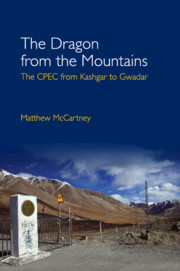Book contents
- Frontmatter
- Dedication
- Contents
- List of Maps and Figures
- List of Tables
- Preface
- Acknowledgements
- 1 Introduction
- 2 Big Infrastructure: Big Problems or Big Benefits?
- 3 CPEC Spillovers Rippling Outwards
- 4 Through the Eyes of Who? Evaluating the Success of the CPEC
- 5 The Dragon Uncoils: Special Economic Zones (SEZs) from Shenzhen to Africa
- 6 The Dragon's Embrace: Pakistan–China Trade Policy
- 7 The Will of the Dragon: The Importance of an Industrial Policy
- 8 Conclusion: The Way of the Dragon or the Way of the Falcon?
- Bibliography
- Index
6 - The Dragon's Embrace: Pakistan–China Trade Policy
Published online by Cambridge University Press: 06 August 2021
- Frontmatter
- Dedication
- Contents
- List of Maps and Figures
- List of Tables
- Preface
- Acknowledgements
- 1 Introduction
- 2 Big Infrastructure: Big Problems or Big Benefits?
- 3 CPEC Spillovers Rippling Outwards
- 4 Through the Eyes of Who? Evaluating the Success of the CPEC
- 5 The Dragon Uncoils: Special Economic Zones (SEZs) from Shenzhen to Africa
- 6 The Dragon's Embrace: Pakistan–China Trade Policy
- 7 The Will of the Dragon: The Importance of an Industrial Policy
- 8 Conclusion: The Way of the Dragon or the Way of the Falcon?
- Bibliography
- Index
Summary
The section ‘The Benefits and Costs of EPZs and SEZs’ in Chapter 5 made a case that what is happening in China, particularly Western China, is of crucial importance to the likely impact of the CPEC on Pakistan. While the CPEC is about infrastructure and FDI, these processes are influenced by overall trade relations between China and Pakistan. Infrastructure links that open up trade between China and Pakistan will make little difference if the two countries charge high tariffs on trade. This chapter outlines the emerging patterns of trade between Pakistan and China, particularly in relation to the signing of the 2006 FTA.
THE CHINA IMPACT ON WORLD TRADE: THE IMPLICATIONS FOR PAKISTAN
In 1979 China had a mix of land shortages and an abundant and reasonably well-educated labour force. The entry of China onto world markets after 1979 from a position of near autarchy had a global impact on relative factor endowments and thereby the comparative advantage of other countries (Wood and Mayer 2011). The value of having a great deal of available land to produce agricultural products, natural endowments of oil, metals and industrial inputs such as cotton, or the ability to produce skill-intensive manufacturing and services in other countries increased as China sought more imports (Renard 2011). Those countries exporting low-skill labour-intensive manufactured goods were set to face the brunt of Chinese competition in export markets.
Chinese potential was realised in the massive surge of Chinese exports. China's exports of manufactures increased from $48 billion in 1990 to $303.5 billion in 2002, from a 3 per cent share of world manufactures in 1995 to 11 per cent in 2006. These exports were initially concentrated in labour-intensive sectors such as textiles, clothing and wood products. Between 1990 and 2006, China's exports of clothing increased from $9.7 billion to $95.4 billion and its world market share from 9 to 31 per cent, with an extra 9 per cent when including Hong Kong (Wood and Mayer 2011). In many cases, this had a devastating impact on other exporters of textile products.
The value of clothing exports from sub-Saharan Africa (SSA) to the US dropped by 25 per cent between 2004 and 2006. For Lesotho, the fall in export value was 15 per cent, mostly in 2005, but exports did stabilise in 2006.
- Type
- Chapter
- Information
- The Dragon from the MountainsThe CPEC from Kashgar to Gwadar, pp. 145 - 160Publisher: Cambridge University PressPrint publication year: 2021



